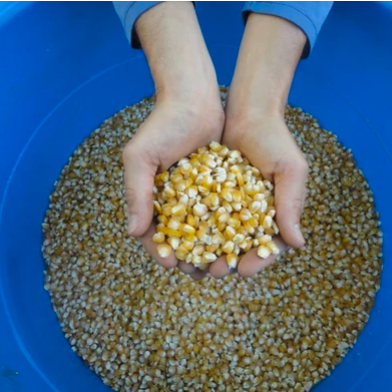
Plant Personality: Corn
 Corn is complicated. As a native of this continent, its deep roots in ancient native American cultures connect us to the past. As the poster-child for genetically modified organisms and over-sweetened, over-processed diets, it connects to deep fears of future possibilities. But, somewhere in between the wild, grassy maize from which cultivated corn originated, and the modern, Round-up-ready monster grain, are hundreds of beautiful, resilient, culinarily versatile, culturally important heirloom varieties. At the Seed Library, our work includes making such such varieties continue to thrive and make it into the hands of home gardeners everywhere. We are lucky that our seed farm and the trial gardens are far enough from other corn growers that we do not need to be concerned with cross-pollination. We currently have five corn varieties in our catalog - each one couldn’t be more different than the other in look and use. Get to know our favorite corns below, then jump to the bottom for growing tips (now is an ideal time to sow corn!).
Corn is complicated. As a native of this continent, its deep roots in ancient native American cultures connect us to the past. As the poster-child for genetically modified organisms and over-sweetened, over-processed diets, it connects to deep fears of future possibilities. But, somewhere in between the wild, grassy maize from which cultivated corn originated, and the modern, Round-up-ready monster grain, are hundreds of beautiful, resilient, culinarily versatile, culturally important heirloom varieties. At the Seed Library, our work includes making such such varieties continue to thrive and make it into the hands of home gardeners everywhere. We are lucky that our seed farm and the trial gardens are far enough from other corn growers that we do not need to be concerned with cross-pollination. We currently have five corn varieties in our catalog - each one couldn’t be more different than the other in look and use. Get to know our favorite corns below, then jump to the bottom for growing tips (now is an ideal time to sow corn!).
Blue Jade Sweet Corn: We were smitten when these darling dwarf plants were growing in our 2013 trials, and enamored when the peeled back the husk revealed steel blue kernels...but the flavor is really what won us over. This corn is hands down one of the best open-pollinated sweet corns we have tasted! The kernels turn from white to steel blue when at the peak eating stage, and turn a bit greener when cooked. Each plant yields about 2 ears. A great variety for small spaces and container gardens. Due to the small plant size, the ears are about half the size of an ear of standard sweet corn.
Calico Popcorn: Use as colorful autumn decoration, or pop them for wintertime movie-watching noshing. Pops most consistently if you freeze the kernels first then throw them directly into a kettle with hot oil. Kernels are yellow, brown, white, purple, red, and blue.
Ashworth Sweet Corn: Gardeners aren't the only ones seeking to satisfy a sweet tooth with corn. Little critters have sweet teeth as well. What does that have to do with this corn? Fred Ashworth of St. Lawrence Nurseries in Potsdam, New York, originally named his variety "'Rat Selected" in honor of the rodents who collected and stowed seed from his barn. Their selections unwittingly showed Fred the sweetest kernels, which they preferred. With good old-fashioned sweet corn flavor and no genetic engineering, we feel it's more important than ever for us to keep this corn alive on our sweetly isolated seed farm.
Otto File Flint Corn: These delicious, gold to orange cobs, also known as Eight Row Flint Corn, originated in New England and were cultivated by northeastern Native American tribes for hundreds of years before making it over to Italy and then back again. Otto File's exceptional, creamy taste, high carotenoid and protein content made it a prized polenta corn in Italy for many years. This variety was passed through many hands before making it to our trial gardens. After growing and tasting it, we decided we had to make sure this variety doesn't disappear. Yields long, narrow 8- 12 inch cobs, one per plant. There is some variation in color and plant height. This variety is grown by our Trials Manager - Erin Enouen. Read more about how Erin grows these seeds here: Finding the Art in Growing Seeds.
Japonica Striped Corn: An heirloom, ornamental variety from Japan grown for it's beautiful striped leaves. Japonica Striped Corn makes an excellent decorative border with wide spacing between plants. Corn has dark purple tassels and burgundy kernels.
Corn Growing Tips:
How: in order for corn kernels to form, the pollen from the corn tassels (the male parts of the plant) must reach the corn ears (the female parts). They are wind-pollinated, so planting configuration is important in order for all plants to receive sufficient pollen. We recommend planting corn in blocks of at least three rows. In other words, aim to plant in the shape of a filled in shape, say, a square, as opposed to long columns of one or two plants side-by-side. Sow seeds about 1 inch deep and about 4 apart. Thin it to 8 to 12 inches apart (depending on variety).
Harvest: once an ear feels full and flush against its leafy sheaf, shuck a test ear to make sure of its readiness.
Seed-save: if you are harvesting a seed crop from your open-pollinated, heirloom corn, let the ears dry on the stalk (until the outer leaf sheaf is papery and dry) before picking. Finish drying them in a well-ventilated, dry space for a few days. They should then be easy to pull off the ears by hand and be stored for next spring!






